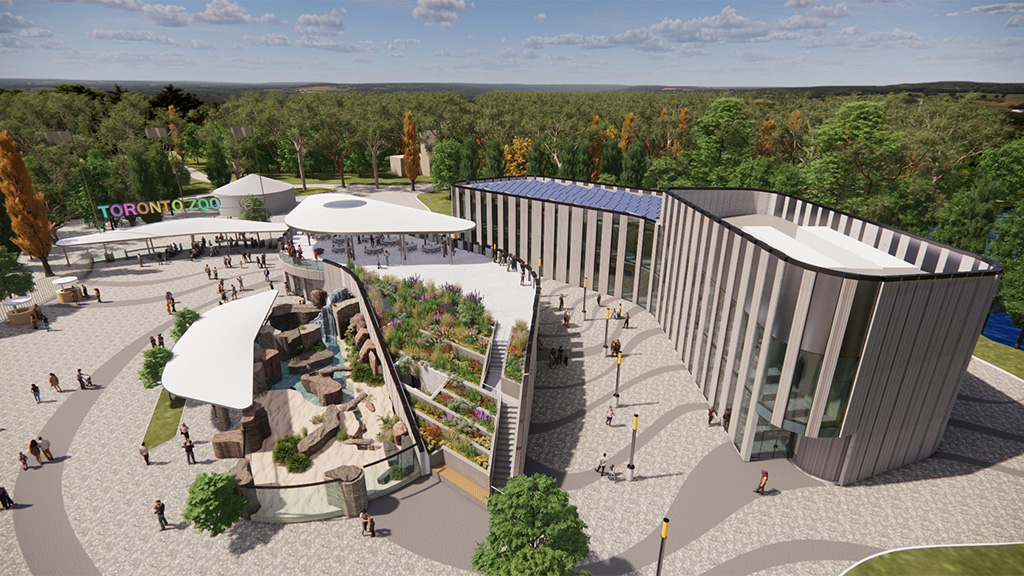Infra
You ‘otter’ see this: PCL breaks ground on conservation centre at Toronto Zoo – Daily Commercial News

There will be more to see at the Toronto Zoo this summer than just the animals.
The zoo recently kicked off its 50th anniversary celebrations with the start of a major, transformative construction project, the Toronto Zoo Community Conservation Centre (TZC3), being constructed by PCL Construction.
“It won’t be long before the visitors at the zoo get to see a separate exhibit called the construction exhibit and all of our workers working day in and day out to start building the concrete, steel and timber structure,” Myke Badry, vice-president and district manager with PCL Constructors Canada Inc., told the Daily Commercial News.
“The area is fenced off with some soon-to-be-released very exciting spots for kids to observe the construction through the fence. The zoo and our people onsite are working together to find a way to make the building of the zoo an exhibit itself.”
Located at 2000 Meadowvale Rd., the project will include two three-storey buildings. The guest services building is 13,272 square feet and the academic building is 20,860 square feet.
In addition to delivering construction management services for the project, PCL is also the mass timber contractor.
“The Toronto Zoo put out a call for construction managers,” explained Badry. “Through the regular process, we answered the call and then we were selected as their construction manager and have been working with them on pre-construction and planning and scope alignment with their budget since six or eight months ago. Now, we’re finally breaking ground on the entrance and the otter exhibit. It’s pretty exciting.”
The zoo opened its doors in 1974 and will celebrate its anniversary on Aug. 15. Leading up to that there will be 50 days of celebration.
A place for learning
The new building will feature a river otter habitat and be the new home to the zoo’s endangered turtle conservation breeding centre, the Blanding’s turtle headstarting facility.
In addition, it will contain an event space, gift shop and offices.
According to a release, the project aims to bring a new, educational arrival experience to zoo guests. In addition to serving as a gateway to the zoo, it will be accessible to the local community.
The scope of work includes taking down the existing buildings at the old entrance to the zoo.
“All the demo of the existing structures is complete,” said Badry. “We’re currently working on site works and underground and excavation is also underway.
“There was an old, existing entrance that got knocked down to make way for the new entrance and visitors’ centre,” he added.
The construction will take place in a few stages and is anticipated to be complete in 28 months.
Once the excavation is complete, the team will work on foundations, followed by the structure. The zoo will remain open throughout construction.
“One of biggest priorities is making sure that there’s a friction-free experience for the patrons of the zoo as well as all the inhabitants of the zoo and that’s all the animals that call the zoo home,” Badry noted.
Sustainability and Indigenous elements incorporated into design
Designed by Zeidler Architecture in association with Jones & Jones Architects + Landscape Architects + Planners the TZC3 includes a new arrival, entrance and orientation plaza.
Toronto Zoo is the first zoo in Canada to establish a collaboration with a university to locate a physical campus onsite.
It will feature multiple labs and classrooms used by students from the University of Toronto Scarborough in addition to Toronto Zoo camps, Zoo School and education programs.
When the classrooms are not being used for educational purposes, they will serve as outreach spaces the community can use for meetings, gatherings, events, townhalls and programs.
The facility is being built to Toronto Green Standard Version 4 and is in keeping with the zoo’s TZNet0 Environmental Sustainability Plan to meet its goal of net-zero by 2030.
Mass timber is the key sustainability feature.
“It’s using a number of sustainable building elements, most importantly mass timber,” said Badry. “It’s going to be a mass timber hybrid steel structure.
“What you will see is mass timber horizontals with steel verticals.”
The team also worked with Two Row Architect as the Indigenous consultant to incorporate Indigenous principles into the design, supporting the zoo’s mission of “two-eyed” seeing.
“Overall, the design of the building takes all the keys from the surrounding Rouge National Park, the river and the nature setting in the zoo and really ties into the environment of the area,” said Badry.
Follow the author on X/Twitter @DCN_Angela.










